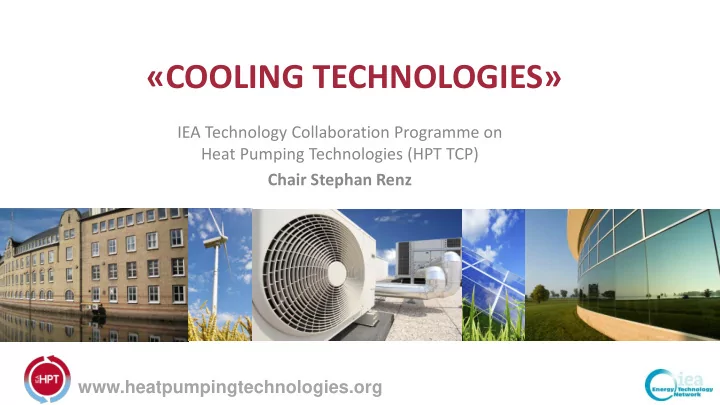

«COOLING TECHNOLOGIES» IEA Technology Collaboration Programme on Heat Pumping Technologies (HPT TCP) Chair Stephan Renz www.heatpumpingtechnologies.org
A/C TECHNOLOGIES AND MARKETS In the Past Expectations for the future • Rapid growth of A/C markets in developing nations with hot, humid • Substantial declines in product climates and lifecycle cooling costs in • Increased frequency of extreme many A/C markets heat waves due to global warming • Higher sales volumes • Continued efficiency improvements • Higher energy efficiency • Transition to low-Global Warming • Transition away from ozone- Potential (GWP) refrigerants depleting substances (ODS) • Advancement of non-vapor- compression A/C technologies • Cooperation with other TCP’s www.heatpumpingtechnologies.org
WHAT IS THE HPT TCP? 16 Participating Countries • A Technology Collaboration Programme (TCP) within the IEA since 1978 • An international framework of cooperation and networking for different HP actors • A forum to exchange knowledge and Austria Japan experience Belgium Netherlands A contributor to technology • Canada Norway Denmark South Korea improvements by RDD&D projects Sweden Finland Switzerland France United Kingdom Germany United States Italy www.heatpumpingtechnologies.org
WHAT IS - HEAT PUMPING TECHNOLOGIES Mechanical compression cycle Thermodynamic cycle in T-s-Diagramme Temperatur lift vs. efficiency Influence of the refrigerant www.heatpumpingtechnologies.org
WHAT IS - HEAT PUMPING TECHNOLOGIES Mechanical compression cycle Large heat pumps .... ...... smalll heat pumps Other heat pump cycles Absorption heat pump Thermo-acoustic heat pump Electro-magnetic heat pump Mechanical vapor recompression www.heatpumpingtechnologies.org
DEVELOPMENT OF SPACE COOLING DEMAND (1/3) Many countries with strong population and GDP growth are in hot and humid climates , further driving increased A/C use. www.heatpumpingtechnologies.org
DEVELOPMENT OF SPACE COOLING DEMAND (2/3) Heat island effect www.heatpumpingtechnologies.org
DEVELOPMENT OF SPACE COOLING DEMAND (3/3) • Aggressive growth of A/C energy consumption by 2050 will be driven primarily by non-OECD countries. • Rising standards of living and population growth drives increased A/C adoption. • Current A/C penetration in developing nations is limited, e.g., 3% in 2010 in India India alone has potential • space cooling demand that is 14 times larger than that of the U.S www.heatpumpingtechnologies.org
CHALLENGES AND OPPORTUNITIES OF COOLING TECH’S • Efficiency of the thermo cycle • Electricity grid (capacity, total energy and peak loads) • Dehumidification • Other energy sources/sinks • Global Warming Potential (GWP) of the refrigerant • Need & Opportunities of storage system • Energy transfer from the room • Existing building stock or new • Energy transfer to the environment • Size of the building • Required temperature lift • Purpose of the building • Decentralised or central solution • Standard of building technologies • Source of electricity (and its GWP) • “Culture” of thermal comfort www.heatpumpingtechnologies.org
EMERGING R&D SOLUTIONS FOR COOLING TECH’S • Advanced Vapor-Compression Systems • A/C technologies that significantly lower refrigerant GWP and energy consumption while maintaining cost-competitiveness; for example: – Low-GWP refrigerants (e.g., natural refrigerants and synthetic olefins) – Climate-specific designs • Emerging Non-Vapor-Compression (NVC) Systems • A/C technologies that do not rely on refrigerant-based vapor-compression and can provide energy savings (with high-volume cost similar to today’s); for example: – Solid-state & caloric (thermoelectric, magnetocaloric) – Electro-mechanical (evaporative, thermoelastic) – Thermally driven (absorption) • Integration of A/C and Other Building Systems • A/C technologies that share excess heat and other resources with other systems to provide significant savings for the building; for example: Capturing waste energy from A/C for water heating and dehumidification – www.heatpumpingtechnologies.org
Outcome from Annex 40 Heat Pumps and NZEBs www.heatpumpingtechnologies.org
RECENT DEVELOPMENTS IN COOLING TECH’S • Membrane air conditioner - Dehumidification by nano-composite membrane instead of cooling - Development of membrane heat and mass exchanger - Development of prototype air conditioner and feasibility test - One of the candidate technologies in DOE report of non-vapor compression HVAC technologies. • Integrated system of refrigeration, air conditioning and freezing - Combined with a heat pump system - Target for commercial sector like supermarket www.heatpumpingtechnologies.org
DIRECT VS. INDIRECT GHG EMISSIONS IMPACTS • 2010 global A/C GHG emissions: Direct (HFC, HCFC refrigerant emissions during operation, end-of-life) 26% or 175 – MMtCO 2 -eq Indirect (CO 2 emissions from electricity generation) 74% or 516 MMtCO 2 -eq – • Electricity consumption is the largest driver of global A/C GHG emissions, but simultaneous pursuit of reductions in BOTH direct and indirect emissions is required to achieve international goals. • Direct emissions in developing countries are typically higher than in developed countries. Few developing countries have in-service recovery or end-of-life recycling regulations – Leads to deliberate venting of refrigerants – www.heatpumpingtechnologies.org
LOW-GWP PRODUCT AVAILABILITY Products using low-GWP, 4 th generation refrigerants are already available in some applications. • Offer comparable or improved efficiency relative to today’s typical equipment Currently available in four key product categories, including ductless split systems, by far the largest market segment globally • (>60% of the market) • Flammability and cost are key limiting factors Example Approved for use in 2012 Global Annual Sales Equipment Status U.S. SNAP Application Submitted U.S. (US$B) Best GWP Detail R-290; R -32 Room and portable <10 $3.4 Residential Ducted split & single-package <700 Multiple candidates $3.3 Ductless split system <10 R-32; R-290 $48.5 Packaged terminal <700 R-32 $0.2 Packaged rooftop unit <700 Multiple candidates $4.6 Commercial Ductless (VRF/VRV) <700 R-32 $10.7 Scroll / recip. chiller <700 DR-55 (R-452B) $8.3 Screw chiller <10 R-513A; R-1234ze(E) (all chillers) Centrifugal chiller <10 R-1233zd(E), R-1234ze(E) Source for market size: Approximate 2012 global sales data (includes equipment using all refrigerants) from BSRIA; U.S approval status from EPA website Commercially available in some global markets; Product under development; Tested in Lab www.heatpumpingtechnologies.org
HPT TCP AND OTHER TCP’S IETS TCP Industrial Technologies and Systems www.heatpumpingtechnologies.org
COOLING TECHNOLOGIES FOR THE NEXT DECADE • Flexible, sustainable and clean system solutions (e.g. in urban areas) using combinations of heat pumping technologies with energy storage , smart grid , solar and wind energy, thermal networks , energy prosumers Thanks for your attention www.heatpumpingtechnologies.org
Recommend
More recommend